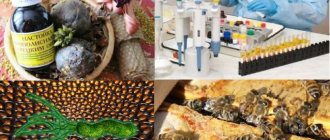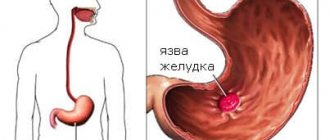The article is written for informational purposes. We do not recommend using any folk remedies. We recommend reading: “Why can’t you use traditional methods?”
Helicobacteriosis
is a dangerous disease that occurs when infected with special microorganisms. Helicobacter pylori bacteria cause stomach pain, heartburn, heaviness, belching, nausea and vomiting. In some cases, the bacteria present on the mucous membranes are inactive. But when immune systems fail, they negatively affect the digestive system as a whole. Gastritis, ulcers and fatal cancer tumors are often serious consequences of this disease.
This disease is transmitted through household contact, as well as through contact with an infected person through mucus and saliva. It has been proven that such spiral-shaped bacteria do not die in the acidic environment of the stomach, and feel comfortable on its walls. Being on the mucous membranes, microorganisms secrete toxic waste products.
The main method of treating helicobacteriosis is modern complex therapy, including two different antibiotics. Traditional medicine has its own methods of combating these dangerous microorganisms. Such methods help normalize gastric juice and also create the necessary protection against Helicobacter pylori on the mucous membrane. They perfectly eliminate severe pain and various discomforts in the stomach.
As a rule, all kinds of folk remedies are used to treat this disease, which are taken in the form of medicinal decoctions and tinctures. Various complex collections of special medicinal plants are often prescribed. They have a multidirectional effect not only on the cause of the appearance of bacteria, but also on the process of their manifestation in the body. It should be noted that treatment with folk remedies is recommended in certain courses to speed up healing and prevent progression of the disease.
Treatment of helicobacteriosis with increased stomach acidity
In this case, it is recommended to boil the flaxseed in water for five minutes. The product should sit for 2 hours, after which it can be filtered. The result should be quite thick mucus, which is indicated for use before meals. The dosage is 1 tablespoon per glass of water. Another method of treating the disease is to take 100 ml of freshly squeezed potato juice for a long time before each meal. It acts as an analgesic and sedative.
An equally effective method of treatment is a decoction of herbs. To prepare it, you should take equal parts of chamomile, yarrow, celandine and St. John's wort. Mix thoroughly and pour boiling water over the mixture at the rate of 4 tbsp. l. for 1 liter of water. The product should sit for 8-10 hours. We filter the resulting infusion and take it in small doses half an hour before each meal. The maximum dose per day should not exceed one glass.
Efficiency of bee product
Propolis is obtained as a result of the vital activity of bees. They collect pollen from plants, their oils, then an enzyme acts on them in the bee’s body.
Insects use propolis as glue in the construction of honeycombs, depositing it on frames, canvases, etc. By itself, it has a sticky consistency, but dries out over time.
With the help of this “ingredient” a special microclimate is created in the hive, due to the presence of essential oils in it. Therefore, bees are not afraid of bacteria and infection. The composition of propolis is influenced by the location where the hives were located, or more precisely, the proximity to the place where honey is collected from useful plants, the pollen of which is used for propolis. Beekeepers use a chisel to collect “glue” from hives; they simply scrape it off. The bee “ingredient” is usually “removed” from the hive with honey, since most of it is on the frame.
To use the above-mentioned bee product for “healing” purposes, it must be heated.
Propolis becomes similar to plasticine in consistency, but does not lose its usefulness. This bee “nectar” contains a large number of microelements that can help get rid of various ailments.
Due to the wide range of beneficial substances in the product described above, it is used for Helicobacter pylori.
Treatment of Helicobacter pylori with propolis is an effective method, despite the fact that this bacterium is resistant even to some antibiotics. This is because honey/propolis contains elements that are active in the fight against harmful gastric bacteria.
Propolis is a “storage” of vitamins (all groups), flavonoids, microelements, amino acids, organic substances (15 classes), biologically active components (more than 200).
All elements of the bee product are well balanced and have a healing effect on the body. These elements rarely end up in the body, and when they get there with propolis, they have a great effect on the pancreas, heart and other organs.
Bee glue:
- Eliminates inflammation.
- Has a bactericidal and antiseptic effect.
- Destroys infections, microorganisms (harmful).
- candidiasis;
- hepatitis;
- tuberculosis;
- Helicobacter and other ailments;
- relieve swelling (of mucous membranes);
- reduces pain or completely eliminates it;
- effective in combating fungus;
- helps normalize metabolism;
- increases immunity;
- stimulates the active functioning of organs (thanks to the microelements in the composition);
- strengthens the gastrointestinal tract, improves its protective mechanism;
- normalizes metabolism and saturates cells with oxygen;
- reduces the development of cancer cells;
- prevents the proliferation of viruses.
Bee “glue” does not have a negative effect on the microflora; it is neither toxic nor harmful to the digestive system.
Propolis is a folk remedy for getting rid of many ailments; it is not only used for treatment, but is also recognized by medicine.
It is used to make many medicines, there are:
Traditional medicine has a large number of recipes with bee products (honey, propolis), which are used to get rid of Helicobacter. Not everyone knows yet that propolis is a very useful ingredient.
Bee “glue” in combination with honey perfectly treats many symptoms of ailments associated with the gastrointestinal tract, which are caused by Helicobacter. According to statistics, this unfortunate bacterium is present in the body of 80% of people.
To combat it, antibiotics are used, as well as medications that include propolis. Bee “glue” began to be used against gastrointestinal diseases 2 centuries ago - in the 19th century. In those years, the effectiveness of treatment was tested during the use of medicines with bee “glue” (home-made).
Treatment of helicobacteriosis with low acidity
In the absence of exacerbation of chronic gastritis, traditional medicine recommends drinking 100 ml of freshly squeezed cabbage juice an hour before meals.
This drink contains a large amount of vitamins that promote rapid healing of damage. You can also use 1 tbsp. l. juice from plantain leaves, previously washed and crushed.
One of the popular recipes is calamus infusion. Crushed calamus rhizomes are poured with boiling water. The proportion should be 1 liter of water per 4 tbsp. l. dry raw materials. It is recommended to consume this remedy 30-40 minutes before meals, half a glass.
What to choose: medications or herbal medicine?
If you have brought yourself to an acute exacerbation of a stomach ulcer or gastritis , the drug regimens of Maastricht V will kill the cause of the disease in 14 days. After this, you can use traditional or alternative methods of treatment: support the liver, increase immunity, remove bad microflora.
There is also the concept of disease and carriage. When there is no discomfort, there are no symptoms described in the article about Helicobacter, then a number of gastroenterologists are inclined to consider this condition as a carriage of Helicobacter pylori - it is still harmless . It may not be treated.
But this harmlessness exists as long as a strong immune defense does not allow the bacteria to multiply.
Traditional medicine and alternative treatment regimens aimed at increasing immunity are completely appropriate here. The same as during remission of the disease. Acute conditions require immediate treatment . Immediate treatment is provided only by medications. For this reason, the corresponding standard Helicobacter therapy schemes were published - so that you know what to do and which doctor to see. And one more thing: having started treatment with antibiotics, it is necessary to maintain the recommended duration of therapy, otherwise eradication will not be seen, and resistance to antibiotics will become 100%.
Propolis tincture in the treatment of Helicobacter pylori
Propolis is an effective treatment for Helicobacter pylori.
The therapeutic effect is achieved due to the fact that propolis has the following properties:
- Antiseptic.
- Antibacterial.
- Antioxidant.
- Anti-inflammatory.
- Vasoconstrictors.
- Immunomodulatory.
In addition, propolis allows you to cleanse tissue cells of toxins. Propolis effectively fights bacteria, reducing their pathological activity. It neutralizes toxins that pathogenic microorganisms secrete during their life processes and promotes the removal of toxins from the body.
Propolis can be used to treat children, but first you need to make sure that there is no allergic reaction to honey or other bee products, which include propolis.
To treat Helicobacter pylori, alcohol tincture of propolis is used. It can be found in pharmacies. Add 10 drops of tincture to 100 ml of water. Take the drug before meals. The course of treatment is 30 days.
Read more: How to make propolis tincture at home?
Recipes for preparing propolis-based products:
- You can prepare an aqueous solution of propolis at home. To do this, you will need 10 g of the substance, which is placed in the freezer for half an hour. This will allow it to crush faster. After removing from the freezer, propolis is crushed into powder, added to a glass of water and kept in a water bath for 60 minutes. The finished solution is cooled and filtered. It is not taken in its pure form. Take 10-15 drops of an aqueous solution of propolis, stir them in 100 ml of water and drink 10 minutes before meals. The shelf life of the prepared solution is 10 days. This recipe is good because it does not contain an alcohol component, so it can be used to treat children.
- It is not necessary to buy an alcoholic tincture of propolis at a pharmacy. It can also be prepared at home. To do this, propolis is grated. As with the previous recipe, it should be frozen in advance. Fill the grated mass with water. Any particles that float to the surface must be removed with a spoon and discarded. The water is drained, and the propolis that has settled below is slightly dried. Then fill it with alcohol and leave to infuse.
- There is another way to prepare alcohol tincture of propolis. To do this, 10 g of the substance is grated and heated in a water bath. Then add 100 ml of medical alcohol with a strength of 70% to the propolis and mix thoroughly. Care must be taken to ensure that the mixture does not boil. Strain the solution through cheesecloth, pour it into a dark glass container and cover with a lid. Store this tincture in a dark place, away from direct sunlight.
- Recipe for preparing 10% propolis tincture in alcohol. In this case, propolis is simply poured with vodka and put in a dark place for 2 weeks. Shake the bottle twice a day. After the specified period, the tincture can be taken. To bring it to the desired concentration, the medicine is simply diluted with water.
- There is a recipe for preparing propolis oil tincture, which is used to destroy Helicobacter pylori. To do this, 100 g of butter is mixed with 20 g of propolis and 10 ml of boiling water. Heat the resulting composition in a water bath. At the same time, it must be stirred all the time so that the mixture does not burn. Heat the propolis for a quarter of an hour. Then the composition is cooled and the refrigerator is removed. The product should be taken 2 times a day 60 minutes before meals in the amount of 1 teaspoon.
- Since propolis has an anti-inflammatory effect, it is used to reduce pain caused by stomach ulcers. You will need to mix a 20% tincture (teaspoon) with 50 ml of novocaine (0.25%). Take this composition 3 times a day 1.5 hours before meals.
To prepare medicines based on propolis, you need to use only pure raw materials. Before grinding a bee product, it should be frozen. Then the ground mass is poured with cool water. All dirt and all other impurities will appear on the surface. They just need to be drained along with the liquid. The propolis remaining at the bottom is slightly dried and used to prepare a tincture or other medicine.
If you prepare the tincture without violating the recipe, and then take it according to the instructions, you can quickly achieve recovery. However, before taking the product for the first time, it is necessary to perform an allergic reaction test. To do this, you just need to chew a small piece of propolis and then swallow it. If after some time redness appears on the skin or dizziness occurs, then treatment with beekeeping products should be abandoned.
Taking an alcohol tincture of propolis for Helicobacter pylori can help get rid of nausea, heartburn, belching, bloating and dyspepsia. The recommended dosage for an adult is 10 drops, and for a child 5 drops. To enhance the healing effect of the tincture and make its taste more pleasant, you can add lemon and honey to it. The maximum effect in the treatment of Helicobacter pylori can be achieved by taking aqueous tincture of propolis and Omeprazole for 21 days.
Taking tincture alone will not get rid of bacteria. It is important to follow a diet, lead a healthy lifestyle, and exercise. This will help improve immunity and speed up recovery.
Helicobacter pylori multiplies due to poor diet, smoking and alcohol abuse. Therefore, you need to properly plan your diet, including fresh vegetables and fruits, you need to avoid eating fried and fatty foods, and it is best to cook meat. You should also remove baked goods and sweets from your diet, replacing them with dried fruits and honey. The honey-nut mixture helps improve immunity.
Features of the bacterium
Helicobacter pylori is a microorganism whose presence is often identified in the bodies of people with diseases of the duodenum and stomach.
This bacterium survives in the aggressive acidic environment of the stomach. Half a century ago, people thought that almost all microorganisms would die under such conditions, but Helicobacter pylori has special protective mechanisms:
- flagella allow it to move along the walls of the stomach and remain invisible in the gastric mucus, which protects this organ from acidity;
- the bacterium is capable of releasing ammonia, thereby making the acidic environment neutral.
Helicobacter pylori can remain in the stomach for years, contributing to the development of diseases. When the bacterium multiplies, it destroys the cells of this organ. Helicobacter produces an enzyme that changes the acidity of the stomach. Because of this, inflammation occurs, which in the chronic form leads to gastritis.
They also negatively affect the gastric mucosa, which leads to ulcers and increases the risk of stomach cancer. Today, Helicobacter pylori is considered a first-class carcinogen, while Helicobacter pylori is an infectious disease. Gastritis and its complications almost always occur as a result of infection with this bacterium.
Flax seed
A decoction of flax seed allows you to envelop the walls of the stomach, forming a protective film on them. This helps to get rid of such symptoms of Helicobacter pylori infection as: heartburn, nausea, pain.
To prepare the decoction, you will need to add 250 ml of water to the flax seed and boil for 5 minutes. Then the container with the broth is covered with a lid and left to infuse for 3 hours. You need to take it one tablespoon 15 minutes before meals.
You can use a decoction of flax seed for stomach ulcers caused by Helicobacter pylori. There is another recipe for preparing the solution. In this case, the flax seed must be crushed, after which it is boiled for 2 hours in 2 liters of water. When the broth has cooled, it needs to be strained. It is taken in courses, the duration of one course is 3 months. You should drink the decoction before each meal.
Find out more:
The benefits and harms of flax seeds, contraindications and how to take them?
Symptoms
There are a number of signs indicating the presence of Helicobacter pylori in the stomach:
- increased gas formation;
- whitish coating on the tongue;
- pain after eating, appearing after one and a half to two hours (usually dull) in the stomach;
- heartburn;
- intestinal disorder with alternating diarrhea and constipation;
- belching accompanied by an unpleasant odor;
- brittle nails;
- feeling of heat in the chest;
- pallor, dry skin;
- nausea;
- jams in the corners of the lips.
Infection occurs through water, kissing, sharing utensils, and dirty hands.
Plantain
Although plantain is most often used as a wound healing agent, it can be used to treat Helicobacter pylori. To do this, it can be eaten in its pure form or brewed in tea.
In its raw form, you need to eat 1 leaf of the plant 3 times a day. This medicine should be taken with plain water.
To prepare tea, you will need to pour 2 tablespoons of dry raw materials with 2 cups of boiling water. The drink is infused for 12 hours, after which it can be used for treatment. Drink tea an hour after eating.
More details:
Useful properties and uses of plantain juice, syrup and seeds
Antibacterial drugs
Macmiror destroys the parasite's genetic material.
The choice of antibacterial drugs that can cope with Helicobacter is small. This is "Trichopol" or "Metronidazole", or "Makmiror".
Trichopolum and Metronidazole are complete analogues. The main active ingredient of the drug, metronidazole, penetrates the microorganism and breaks down, releasing toxic substances.
They destroy the parasite's genetic material. The main active ingredient of Macmiror is nifuratel. It simultaneously inhibits the growth of bacteria and prevents the proliferation of microorganisms.
The peculiarity of this drug is that nifuratel does not reduce the patient’s overall immunity, but, on the contrary, improves the body’s defenses. Macmiror is a second-line drug. It is prescribed if treatment with metronidazole does not give the expected result. This medicine is used in the treatment of peptic ulcers in children.
Antimicrobial folk remedies for helicobacteriosis
In addition to antimicrobial properties, the infusion (from centaury, St. John's wort and elecampane roots) has calming and analgesic properties. You should take the herbs in equal parts, mix and pour boiling water at the rate of 2 tbsp. l. mixture per half liter of water. After wrapping the product, you should leave it for half an hour. And then, after straining, you can drink 100 ml in between meals. You can also mix St. John's wort with calendula and yarrow, which perfectly destroy Helicobacter pylori bacteria and also ease the course of the disease by relieving pain.
Since ancient times, an infusion based on pear and apple flowers, as well as strawberries and lingonberry leaves, has been used to relieve the symptoms of this disease. Mix these ingredients in equal proportions and pour boiling water over them in a ratio of 4 tbsp. l. for 1 liter of water. After straining, the infusion can be consumed between main meals, half a glass.
Folk remedies are selected depending on the course of the disease and the patient’s condition. At the same time, it is recommended to exclude fatty, spicy, salty and heavy foods from the diet. Do not drink alcohol during the course of treatment and avoid stressful situations.
Diagnostics
To determine an accurate diagnosis, specialists use an invasive diagnostic method - endoscopy followed by a biopsy of stomach tissue and laboratory tests. Invasive diagnosis is considered the most accurate. The doctor takes tissue from the gastric mucosa and examines it for the presence of foci of inflammation and pathogenic microorganisms themselves.
Laboratory examination includes 4 methods:
- breath test for Helicobacter pylori;
- cytological examination;
- blood analysis;
- Ultrasound of the peritoneal organs;
- stool analysis.
To protect itself from the action of gastric acid, the bacterium secretes a specific enzyme - urease. It has a unique property - the splitting of urea into ammonia and carbon dioxide. They are released when you breathe, so they can be detected in a urease breath test. It is carried out using a urea solution, which is labeled with isotopes of the carbon atom. For pregnant women and children, it is customary to use the safer urea test.
A stool test for Helicobacter pylori can detect even a small number of pathogenic microorganisms and is the most reliable method of detecting them.
The serological method of enzyme immunoassay (ELISA method) is also used to diagnose Helicobacter pylori; it allows you to determine the presence of antibodies to bacteria in the blood plasma
Cytological analysis demonstrates the presence of bacteria in the stomach mucus. The test is considered positive if the doctor finds at least one Helicobacter pylori. Depending on the number of microorganisms, there are 3 degrees of contamination:
- weak – up to 20 bacteria;
- moderate - from 20 to 40 pieces;
- high – over 40.
Smears of gastric mucus are taken using fibrogastroduodenoscopy. This method of examining the gastrointestinal tract involves using a probe.
Preventive measures
Helicobacter is transmitted through household means, so in order to avoid infection, you must wash your hands thoroughly after visiting the toilet, coming from outside, and before eating. Before consumption, fruits and vegetables are washed well, then doused with boiled water. Meat products and eggs must be cooked and not eaten half-baked. Helicobacter do not live in the open air and die immediately. Upon contact with a sick person, it can be transmitted through saliva and mucus. The risk group includes relatives of the patient living with him.
If a person gets sick, a bacteria is found in him, and after some time he is cured, he needs to follow a diet and preventive measures so that the disease does not relapse. To do this, it is recommended to take rosehip syrup for a month after recovery. Dose: 1 teaspoon per day.
It is imperative to treat carious teeth and remove plaque; the bacteria appears first in the oral cavity, then penetrates the stomach.
For prevention purposes, it is necessary to monitor your health and maintain your immunity, since in a weakened state microorganisms multiply. Fresh air and exercise, a contrast hardening shower, and airing the apartment are an excellent way to fight Helicobacter. In the spring and autumn, it is recommended to take a complex of vitamins and minerals, eat healthy vegetables, fruits, and dairy products. In general, lead a correct lifestyle, and then the bacteria will bypass the body.
Scientists are working to create a vaccine that would protect people from dangerous bacteria transmitted through household contact.
How is an infection treated?
To eliminate Helicobacter, a combination therapy method is used. Acid-reducing agents, antibiotics, and drugs that cause scarring of ulcers are prescribed.
Among the drugs used for Helicobacter eradication:
- proton pump inhibitors: Omez, Rabiet, Lansoprazole;
- antibiotics: metronidazole, clarithromycin, amoxicillin;
- antiulcer drugs: De-Nol, Vikair, Vikalin.
This is the first line of Helicobacter eradication. It is prescribed for low antibiotic resistance and good tolerability. Since antibiotics have a detrimental effect on the intestinal microflora, probiotics can be additionally prescribed.
Propolis against Helicobacter pylori is not only a folk remedy. Propolis is effectively used in one of the treatment options, as well as at the end of the main course of treatment to consolidate the therapeutic effect.
Ancient sources
Studies have shown that plants characterized in Ayurveda as capable of treating the gastrointestinal tract are effective against Helicobacter:
- Santi (ginger).
- Rasona (garlic).
- Kaladjaji (nigella sativum).
- Campillaca (Mallotus philippines).
- Amraganji harirda (turmeric).
- Chitraka.
Restoring health is possible if you pay attention to the sources left by your ancestors. Natural ingredients can remove the microbe. After treatment with antibiotics, use plants for prevention. Doubts about soda - use it to make cakes!
Ancient sources provide methods for cleaning the stomach using sodium bicarbonate. One thing is good: unconventional methods are being confirmed. It is worth listening more to the voice of the ancients.
Beneficial features
Propolis is one of the few natural complexes that has a naturally balanced and beneficial composition for humans. Resins, essential oils, wax, alcohols, supplemented with vitamins and minerals, determine its versatility, characteristic of all beekeeping products.
It is used by bees as an antiseptic and disinfectant. Its ability to prevent decomposition processes and preserve rotting products is indispensable for external use and is used in the treatment of internal diseases. External and local use of propolis is in use in modern pharmaceuticals, dentistry, and cosmetology.
Gastroenterology recognizes the bactericidal and bacteriostatic effect of propolis, including on Helicobacter pylori, but allows its use only as a dietary supplement against the background of the main treatment along with antibiotics against the causative agent of problems.
Traditional healers use propolis as the basis for all remedies and regimens used for gastrointestinal problems associated with Helicobacter pylori infection. This is explained not only by its pronounced antibacterial effect, but also by:
- anesthetic;
- anti-inflammatory;
- immunomodulatory;
- general strengthening;
- potentiating;
- healing and regenerating.
Propolis supports the body and helps restore the natural balance of microflora. It is believed that its use has a probiotic effect on the environment of the intestines and oral cavity, this helps to avoid the consequences of dysbiosis, which often accompanies Helicobacter pylori therapy.





